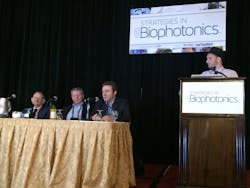BIOPHOTONICS-BASED INNOVATION: Strategies in Biophotonics highlights moral imperative, practical matters
"It is the responsibility of those involved in today's biomedical research enterprise to translate the remarkable scientific innovations we are witnessing into health gains for the nation."1 That quote (by former NIH director Elias Zerhouni) launched Robert Nordstrom's presentation at Strategies in Biophotonics (Boston, Sept. 9-11, 2014) and articulated a moral imperative that carried through the entire conference and exhibition, including the closing keynote by Aydogan Ozcan on the democratization of biomedical imaging, diagnostics, and measurement.
With its focus on helping system and device developers prepare and launch biophotonics-based innovations, the conference covered a range of topics from emerging technologies, to selecting strategies and system components, to case studies in systems development for meeting market needs. Presentations also looked at some of the hurdles involved in making photonics-based medical innovations reach their intended goals: Leading a panel of medical practitioners, Fabian D'Souza, MD, MBA, of Boston Strategic Partners demonstrated the importance of understanding practitioners' priorities and workflows when developing new tech for healthcare, while a lively discussion led by Dan Gareau, Ph.D., captured the struggle between tradition and emerging potential in understanding and meeting healthcare needs. John Dexheimer of Lightwave Advisors opened a third panel discussion by noting that the total number of venture capital deals for bio and medical devices has remained stable over the past 7 years, but that the value of the average deal has declined more than 25 percent in the same period. Then, Dexheimer led representatives of angel investing, venture capital, and corporate innovation investment in exploring funding and partnership options for technology innovators.
Exhibit highlights
Among the 40+ exhibits, Gooch & Housego (Ilminster, Somerset, England) debuted a compact, motorized optical delay line-a device that "folds" a light beam to achieve a long interferometer path length in a small space-to enable image formation in compact optical coherence tomography (OCT) systems. The customizable chassis promises to fit into any modular architecture; applications include early diagnosis of macular degeneration and glaucoma. For spectroscopy applications, DELTA Optical Filters (Hørsholm, Denmark) showcased a wedge-shaped near-infrared (NIR) bandpass filter with spectral properties that vary linearly along one side. With an adjustable center wavelength, it can replace multiple dedicated filters; also, it offers blocking better than OD 3 over the complete reflection range, minimal autofluorescence, and high laser damage threshold.MPB Communications (Montreal, QC, Canada) introduced a continuous-wave (CW) fiber laser, the 2RU-VFL-P-500-750-B1R, that emits at 750 nm with up to 500 mW of output power for super-resolution microscopy. An all-fusion-spliced optical train enables unprecedented stability, the company says. And Plainview, NY-based tec5USA displayed its CGS CCD OEM spectrometer for use in portable and handheld instrumentation, which performs ultraviolet (UV)-NIR spectral data acquisition with a resolution of approximately 2 nm in the UV-visible and 3.5 nm in the NIR.
The event was sponsored by Cambridge Technology, Hamamatsu, Hinds Instruments, and Optimax Systems.
1. E. A. Zerhouni, N. Engl. J. Med., 353, 15, 1621–1623 (2005).

Barbara Gefvert | Editor-in-Chief, BioOptics World (2008-2020)
Barbara G. Gefvert has been a science and technology editor and writer since 1987, and served as editor in chief on multiple publications, including Sensors magazine for nearly a decade.

